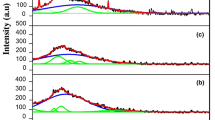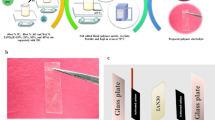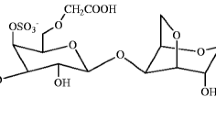Abstract
A biopolymer electrolyte consisting of iota-carrageenan (I-Carrageenan) and LiCl is prepared using solution casting method. XRD analysis confirms the enhancement in amorphous nature of the prepared polymer electrolytes due to the incorporation of LiCl. Fourier transform infrared (FTIR) spectroscopy is used to analyze the complexation of electrolytes. Electrochemical impedance spectroscopy is utilized to find the ac electrical conductivity of the electrolytes. The combination of 1.0 g I-Carrageenan and 0.3 g LiCl displays highest ionic conductivity value of 5.33 × 10−3 S cm−1 at room temperature. Transference number measurements indicate that the conductivity process is predominantly by Li+ ions. Lithium ion conducting battery is constructed with the highest conducting polymer electrolyte, and its discharge performance is analyzed.










Similar content being viewed by others
References
Changyu T, Ken H, Qiang F, Pulickel MA, Haleh A (2012) High ion conducting polymer nanocomposite electrolytes using hybrid nanofillers. Nano Lett 12:1152–1156
Virya A, Liana K (2017) Polyacrylamide-lithium chloride polymer electrolyte and its applications in electrochemical capacitors. Electrochem Commun 74:33–37
Rani MSA, Rudhziah S, Ahmad A, Mohamed NS (2014) Biopolymer electrolyte based on derivatives of cellulose from kenaf bastfiber. Polymers 6:2371–2385
Vijaya N, Selvasekarapandian S, Sornalatha M, Sujithra KS, Monisha S (2017) Proton-conducting biopolymer electrolytes based on pectin doped with NH4X (X=Cl, Br). Ionics 23(10):2799–2808
Sohaimy MIH, Isa MIN (2015) Effect of ammonium carbonate salt concentration on structural and ionic conductivity of cellulose based solid polymer electrolytes. Fibers and Polymers 16(5):1031–1034
Rudhziaha S, Rani MSA, Ahmad A, Mohamed NS, Kaddami H (2015) Potential of blend of kappa-carrageenan and cellulose derivatives for green polymer electrolyte application. Ind Crop Prod 72:133–141
Chatterjee B, Kulshrestha N, Gupta PN (2016) Nano composite solid polymer electrolytes based on biodegradable polymers starch and poly vinyl alcohol. Measurement 82:490–499
Tuvikenea R, Truusa K, Vaherb M, Kailasb T, Martinc G, Kersenc P (2006) Extraction and quantification of hybrid carrageenans from the biomass of the red algae Furcellaria lumbricalis and Coccotylus truncates. Proc Estonian Acad Sci Chem 55(1):40–53
Yao Z, Wu H, Zhang S, Du Y (2014) Enzymatic preparation of κ-carrageenan oligosaccharides and their antiangiogenic activity. Carbohydr Polym 101(0):359–367
Volery P, Besson R, Schaffer-Lequart C (2004) Characterization of commercial Carrageenans by Fourier transform infrared spectroscopy using single-reflection attenuated total reflection. J Agric Food Chem 52:7457–7463
Tanaka T, Lu T, Yuasa S, Yamaura K (2001) Structure and properties of poly (vinyl alcohol)/κcarrageenan blends. Polym Int 50(10):1103–1108
Mobarak N, Jumaah FN, Ghani MA, Abdullah MP, Ahmad A (2015) Chemical interaction and conductivity of carboxymethyl κcarrageenan based green polymer electrolyte. Electrochim Acta 175:224–231
Shuhaimi NEA, Alias NA, Majid SR, Arof AK (2008) Electrical double layer capacitor with proton conducting κ-carrageenanchitosan electrolytes. Funct Mater Lett 1:195–201
Karthikeyan S, Selvasekarapandian S, Premalatha M, Monisha S, Boopathi G, Aristatil G, Arun A, Madeswaran S (2016) Proton-conducting I-carrageenan-based biopolymer electrolyte for fuel cell application. Ionics 23:2775–2780
Jumaah FN, Mobarak N, Ahmad A, Ghani MA, Rahman MYA (2014) Derivative of iota-carrageenan as solid polymer electrolyte. Ionics 21(5):1311–1320
Shamsudin IJ, Ahmad A, Hassan NH, Kaddami H (2016) Biopolymer electrolytes based on carboxymethyl-carrageenan and imidazolium ionic liquid. Ionics 22(6):841–851
Ng CA, Camacho DH (2015) Polymer electrolyte system based on carrageenan-poly(3,4-ethylenedioxythiophene) (PEDOT) composite for dye sensitized solar cell. IOP Conf Series: Mater Sci Eng 79:012020
Moniha V, Alagar M, Selvasekarapandian S, Sundaresan B, Boopathi G (2017) Conductive bio-polymer electrolyte iota-carrageenan with ammonium nitrate for application in electrochemical devices. J on-Crystalline solids 481:424–434
Premalatha M, Mathavan T, Selvasekarapandian S, Monisha S, Selvalakshmi S, Vinoth Pandi D (2017) Tamarind seed polysaccharide (TSP)-based li-ion conducting membranes. Ionics 23(10):2677–2684
Perumal P, Christopher Selvin P, Selvasekarapandian S (2018) Characterization of biopolymer pectin with lithium chloride and its application to electrochemical devices. Ionics. https://doi.org/10.1007/s11581-018-2507-5
Leena Chandra MV, Karthikeyan S, Selvasekarapandian S, Premalatha M, Monisha S (2017) Study of PVAc-PMMA-LiCl polymer blend electrolyte and the effect of plasticizer ethylene carbonate and nano filler titania on PVAc-PMMA-LiCl polymer blend electrolyte. J Polymer Eng 37(6):537–645
Hodge RM, Edward GH, Simon GP (1996) Water absorption and states of ater in semicrystalline poly (vinyl alcohol) films. Polymer 37(8):1371–1376
Ravi M, Song S, Wang J, Wang T, Nadimicherla R (2015) Ionic liquid incorporated biodegradable gel polymer electrolyte for lithium ion battery applications. J Mater Sci Mater Electron 2:1370–1377
Hu P, Chai J, Duan Y, Liu Z, Cui G, Chen L (2016) Progress in nitrile-based polymer electrolyte for high performance lithium batteries. J Mater Chem A. https://doi.org/10.1039/C6TA02907H
Chopin T, Whalen E (1993) A new and rapid method for carrageenan identification by FT IR diffuse reflectance spectroscopy directly on dried, ground alga material. Carbohydr Res Res 246:51–59
Jumaah FN, Ahmad A, Mobarak NN (2013) Characterization of iota-carrageenan and its derivative based green polymer electrolytes. AIP Conference Proceedings 1571:768. https://doi.org/10.1063/1.4858748
Maurya K, Neelam Srivastava SA, Hashmi S, Chandra (1992) Proton conducting polymer electrolyte: II poly ethylene oxide+ NH4I system. J Mater Sci 27(23):6357–6364
Pereira L, Amado AM, Critchley AT, van de Velde F, PJA R-C (2009) Identification of selected seaweed polysaccharides (phycocolloids) by vibrational spectroscopy (FTIR-ATR and FTRaman). Food Hydrocoll 23(7):1903–1909
Campo VL, Kawano DF, da Silva DB Jr, Carvalho I (2009) Carrageenans: biological properties, chemical modifications and structural analysis—a review. Carbohydr Polym 77:167–180
Mobarak N, Ramli N, Ahmad A, Rahman MYA (2012) Chemical interaction and conductivity of carboxymethyl κ-carrageenan based green polymer electrolyte. Solid State Ionics 224(0):51–57
Monisha S, Selvasekarapandian S, Mathavan T, Milton Franklin Benial A, Manoharan S, Karthikeyan S (2016) Preparation and characterization of biopolymer electrolyte based on cellulose acetate for potential applications in energy storage devices. J Mater Sci: Mater Electron 27(9):9314–9324
NirmalaDevi G, Chitra S, Selvasekarapandian S, Premalatha M, Monisha S, Saranya J (2017) Synthesis and characterization of dextrin-based polymer electrolytes for potential applications in energy storage devices. Ionics 23(12):3377–3388
Rodrigues LC, Barbosa PC, Silva M, Smith MJ (2007) Electrochemical and thermal properties of polymer electrolytes based on poly (epichlorohydrin-co-ethylene oxide-co-ally glycidyl ether). Electrochim Acta 53(4):1427–1431
Taib NU, Idris NH (2014) Plastic crystal-solid biopolymer electrolytes for rechargeable lithium batteries. J Membr Sci 468:149–154
Boukamp BA (1986) A non linear least squares fit procedure for analysis of immittance data of electrochemical studies. Solid State Ionics 20:31–44
Boukamp BA (1986) A package of impedance admittance data analysis. Solid State Ionics 18&19:136–140
Ramesh S, Shanti R, Morris E (2013) Employment of [Amim] Cl in the effort to upgrade the properties of cellulose acetate based polymer electrolytes. Cellulose 20:1377–1389
Sivadevi S, Selvasekarapandian S, Karthikeyan S, Sanjeeviraja C, Nithya H, Iwai Y, Kawamura J (2014) Proton-conducting polymer electrolyte based on PVA-PAN blend doped with ammonium thiocyanate. Ionics 21:1017–1029
Monisha S, Mathavan T, Selvasekarapandian S, Milton Franklin Benial A, Latha PM (2016) Preparation and characterization of cellulose acetate and lithium nitrate for advanced electrochemical devices. Ionics 23:2697–2706
Malathi J, Kumaravadivel M, Brahmanandhan GM, Hema M, Baskaran R, Selvasekarapandian S (2010) Structural, thermal and electrical properties of PVA-LiCF3SO3 polymer electrolyte. J Non-Crystalline solids 356:2277–2281
Ramesh S, Arof AK (2001) Structural, thermal and electrochemical cell characteristics of poly (vinyl chloride)-based polymer electrolytes. J Power Sources 99:41–47
Popielarz R, Chiang CK, Nozaki R, Obrzut J (2001) Dielectric properties of polymer/ferroelectric ceramic composites from 100 Hz to 10 GHz. Macromolecules 34:5910–5915
Wagner JB, Wagner C (1957) Electrical conductivity measurements on cuprous halides. J Chem Phys 26:1597–1601
Ramlli MA, Isa MIN (2016) Structural and ionic transport properties of protonic conducting solid biopolymer electrolytes based on carboxymethyl cellulose doped ammonium fluoride. J Phys Chem B 120(44):11567–11573
Tan W, Arof AK (2006) Transport properties of hexanoyl chitosan-based gel electrolyte. Ionics 12:149–152
Sikkanthar S, Karthikeyan S, Selvasekarapandian S, Arunkumar D, Nithya H, Junichi K (2016) Structural, electrical conductivity, and transport analysis of PAN–NH4Cl polymer electrolyte system. Ionics 22:1085–1094. https://doi.org/10.1007/s11581-016-1645-x
Sampath Kumar L, Christopher Selvin P, Selvasekarapandian S (2018) Tamarind seed polysaccharide biopolymer membrane for Lithium ion conducting battery. Ionics. https://doi.org/10.1007/s11581-018-2541-3
Kingslin Mary Genova F, Selvasekarapandian S, Karthikeyan S et al (2015) Study on blend polymer (PVA - PAN) doped with lithium bromide. Polymer science 57:851–862
Kingslin Mary Genova F, Selvasekarapandian S, Vijaya N, Sivadevi S, Premalatha M, Karthikeyan S (2017) Lithium ion-conducting polymer electrolytes based on PVA–PAN doped with lithium triflate. Ionics 23:2727–2734
Janaki Rami Reddy T, Achari VBS, Sharma AK, Narasimha Rao VVR (2007) Preparation and electrical characterization of (PVC+KBrO3) polymer electrolytes for solid state battery applications. Ionics 13:435–439
Author information
Authors and Affiliations
Corresponding author
Rights and permissions
About this article
Cite this article
Chitra, R., Sathya, P., Selvasekarapandian, S. et al. Synthesis and characterization of iota-carrageenan solid biopolymer electrolytes for electrochemical applications. Ionics 25, 2147–2157 (2019). https://doi.org/10.1007/s11581-018-2687-z
Received:
Revised:
Accepted:
Published:
Issue Date:
DOI: https://doi.org/10.1007/s11581-018-2687-z




